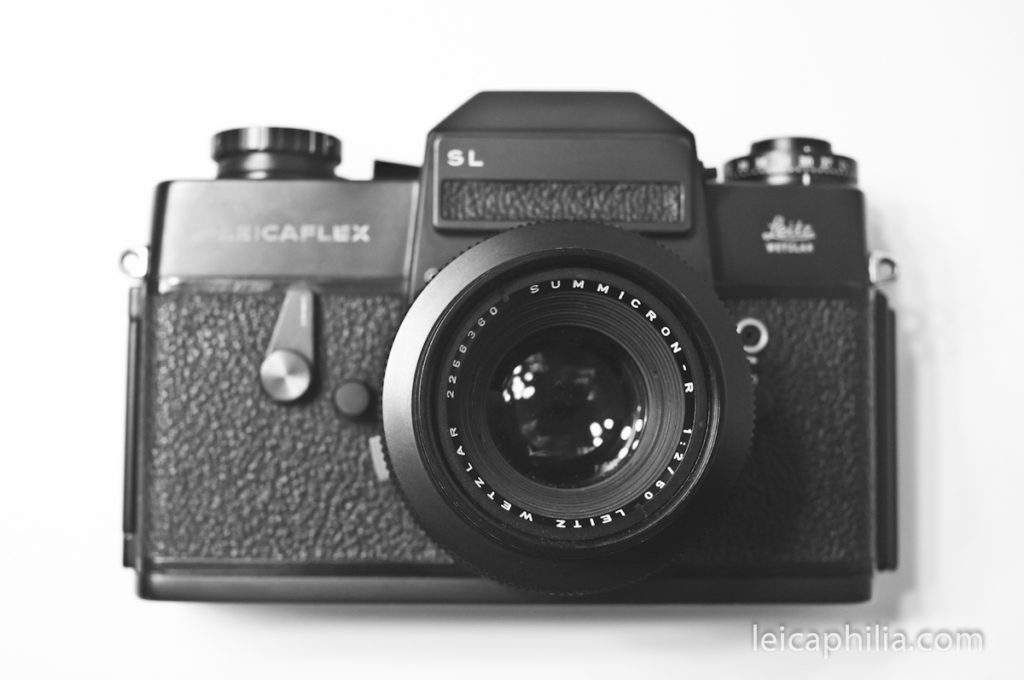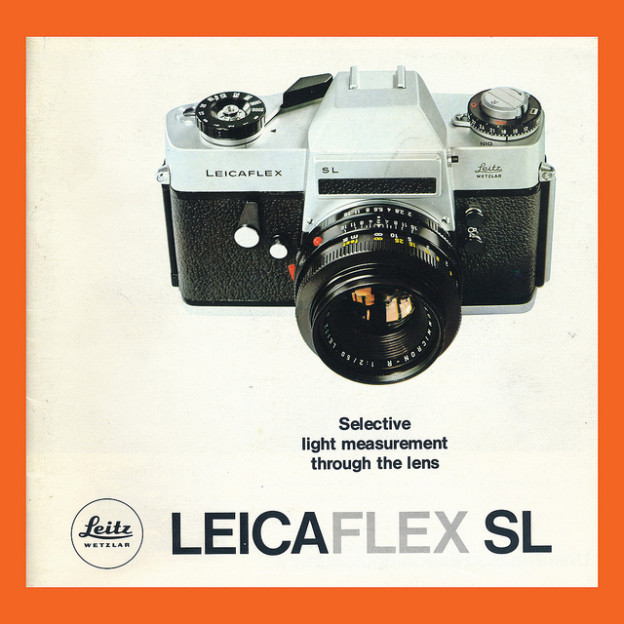 The Leica R9. The end of the line of Leica Film SLRs
The Leica R9. The end of the line of Leica Film SLRs
I’ve written elsewhere of my admiration of Leica’s Reflex film cameras – the Leicaflex SL in particular. It’s ridiculously overbuilt, solid as a brick, pretty much bomb proof. Plus, you get to use arguably the best 35mm SLR optics ever made; the easily obtainable Summicron-R 50mm f2 is about as good as it gets for a standard focal length SLR lens, if that’s your thing.
I currently own 2 SL’s, one black chrome and one chrome. The chrome version is essentially new. I bought it from a nice woman whose dad owned a camera store in Boston. He apparently had put it away new in the box with a Summicron-R 50mm f2. She found it on his shelves after his death, still unused [yup, the box serial number matches the body]. I bought it, and the body sits in the box, while I’ve attached the ridiculously pristine Summicron to a user black chrome SL body. Nice rig; really nice rig.
A few months ago I initiated a fresh round of gear purge, including the sale of my black chrome SL. I had intended to sell the body only, but somewhere along the way a reader (let’s call him Mr. X) asked about it and I ended up selling him the body with the pristine Summicron. I sent it off reluctantly, with a slight regret. Now I’d have one SL body (the new chrome SL) but no lens to use with it, and chances are I’d never find a new Summicron-R the likes of what I’d just sold. Oh well. As fortune would have it, Mr. X didn’t find my SL the amazing Leica he’d been expecting (when I asked him what he didn’t like about the camera he said the viewfinder was no brighter than his Olympus OM2 and he had expected something more. Sigh.) so of course I told him to send it back. Given the SL he had in his hands had, without a doubt, the nicest vintage Summicron-R he’d ever find, and given as well my lingering regret after having sold it, I figured this was kizmet at work, the universe giving me a mulligan.
So, having been given a second chance with my Leicaflex, I did what most Leicaphiles do when they get a new Leica – I took a lot of pictures of my cats while admiring the cool camera I was using. Not any cat pictures, mind you, but gritty black and white “Decisive Moments”, animal reportage at its finest, photos possessing that most elusive of Barthian ontological realities – the “punctum” – no doubt a function of having been produced with a legendary hand-assembled Leitz camera with a second generation “Cron-R.”
*************
 The Leicaflex SL. If you like the M3, You’ll Love This Camera
The Leicaflex SL. If you like the M3, You’ll Love This Camera
When I was 12, newly initiated into a subsequent lifetime of camera gear enthusiasm, presently lusting after a Nikon F (I couldn’t even conceive of owning a Leicaflex; it and the Alpa SLR were unobtainable objects for simple folks like me, to be dreamed of only), I ended up confronting the sad reality that my gear ownership, at least while under my parent’s roof, would be compromised. While I had my eyes set on “professional” cameras like the F, I’d never be able to afford one on my own, and I also wouldn’t be able to convince my parents – good, solid lower-middle class burghers – to buy one for me, their reasoning being that nothing could justify buying the Nikon for $350 when I could buy a perfectly good camera for $125, something like a Minolta. Certainly, my parents pointed out, the Minolta was more than adequate for the needs of a 12 y/o. And so, thrift and practicality having triumphed, I ended up with a brand new chrome Minolta SRT-101 with 50mm Rokker, a perfectly functional camera that I despised from the day I got it because it had no soul. How do you, as a 12 y/o, articulate to your folks that, for someone besotted with the idea of photography, your camera, in addition to meeting minimal practical concerns, needed to speak to you emotionally?
Thus began my aversion to Minolta cameras, and by extension, to Leica reflex cameras, or more particularly, the Minolta Leica R’s, tainted as they were by association with a garden variety Japanese camera producer. The original Leitz SLR’s – the Leicaflex, SL and SL2 – were designed and built by Leitz in Wetzlar, built to the same standards as the mechanical M’s. They were, and are, beautiful mechanical devices; solid, overbuilt no-nonsense teutonic instruments. But they made a marginal impact in the market because they arrived too late, the first Leicaflex appearing in 1964 5 years after the introduction of the iconic Nikon F. And, in spite of the fact that Leitz sold the bodies at a loss, intending to make up the difference through the sale of the R optics, they were expensive, maybe double the price of an F body, while the price of the system lenses made the whole notion of a Leicaflex cost-prohibitive for most professional photographers. Faced with these market realities, beginning in 1976 Leitz partnered with Minolta to produce the R3, their first auto-exposure camera, accessing Minolta’s technology and expertise and assembling the resulting SLR’s in Portugal to reduce costs. The R4 and R5 were subsequent variations on the same auto-exposure theme.
 The Electronic Leica R7. Some People Love Em
The Electronic Leica R7. Some People Love Em
In 1988, Leitz returned the R series to its roots with the introduction of the all-mechanical TTL metered R6, now manufactured again in Germany at their new factory in Solms. It was, essentially, a companion piece to the M6, a reach back to Leitz’s all-mechanical history. Given the state of 80’s era technology, it was also the first signs of Leica’s hedging of any pretense that the R system might function as a reasonable professional alternative to the Nikon and Canon professional SLR systems, although the 90’s era R7 did offer an auto-exposure alternative through 1997. Leica replaced the R7 with the R8, shortly to be followed by the R9, a completely new technical and aesthetic all-auto design, soon to referred to as “the Hunchback of Solms.” You either love it or hate it. Personally, I think they’re incredibly cool, having aged wonderfully from an aesthetic standpoint, soon to be a classic, but they’re still expensive even today and the latest R optics remain absurdly expensive. And, if your über-electronic R8 craps out, well, you’ve now got a very expensive door stop.
 The Hunchback of Solms
The Hunchback of Solms
*************
Which leads us back to the original Leicaflex and the SL’s. If you’re looking for an SLR with the minimalist sexiness of the M5, you can’t do better than a Leicaflex, although I’d steer clear of the original Leicaflex – no TTL metering, with an ugly rectangular metering window on the front of the pentaprism – in favor of the TTL metered SL or SL2. Leicaphiles who know better than me claim the SL2 to be a marked improvement on the SL, but I’ve owned both and can’t tell much difference between the two. As best I can tell, the “improvements” of the SL2 consist of a more sensitive meter and a mirror redesigned to accommodate the newly introduced 16 and 19mm R lenses.
As for my black chrome SL with ‘minty’ 50mm Summicron, it’s back for sale, me having exhausted its creative potential in a few months of marathon cat reportage, and also because my wife won’t let me buy a Colnago C60 unless I unload a few of my photographic toys.
 A Colnago C60. I Want One.
A Colnago C60. I Want One.
That’s it, below. Great camera. No surprises, everything works. Meter works perfectly. the Summicron looks new and comes with the Leitz 12564 hood, also in like new condition. For $550, shipped to your door, it’s yours. If you don’t like it, send it back. Don’t make me put it on Ebay. SOLD







